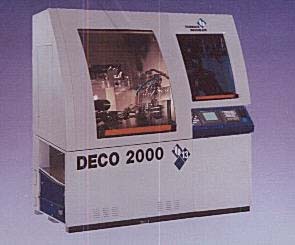Tornos Innovative Swiss Automatic Design Has Grown Into a Family
Technology targeted the void in turning small parts.
When Tornos-Bechler S.A. (Moutier, Switzerland) introduced its innovative Deco 2000 Swiss automatic machine for small part turning in 1996, the Deco 7 mm diameter capacity machine was only the beginning. The machine concept filled a void in the marketplace and was immediately well received. Today, Tornos offers four machines in the Deco 2000 series in these capacities: 10 mm, 13 mm, 20 mm, and 26 mm capacities.
Essentially, the Deco 2000 concept combines the benefits of cam-operated lathes—speed, reliability, and productivity—with the strengths of CNC automatic lathes—flexibility, versatility, and precision.

The concept is based on three core elements: PNC-Deco Parallel Numerical Control; TB-Deco programming software; and optimized mechanics. The concept puts two fundamental ideas to work:
- Parallel operation of all processes
- Elimination of non-productive time during machining
PNC-Deco parallel numerical control
The PNC-Deco control involves two innovations:
- A central clock that acts as an "electronic cam"
- Virtual electronic cams
In this way, the PNC-Deco control mimics the action of a conventional cam-operated machine electronically. On a conventional machine, each cam performs one action, such as the motion of a tool. The camshaft performs overall control and synchronization. As such, several cam actions can occur simultaneously.
The electronic control stores toolpaths as data tables. Each axis has its own controller chip or "electronic cam" that stores only its toolpath for the part as a step table. The step table is a step-by-step sequence of moves in one axis or two axes.
The reading and executing of those steps is a function of the clock signal generator, which executes a new set of steps each 8 milliseconds. Each "electronic cam" executes the given distance moves at the given times. No path calculations are required. Three types of data tables are used: 1) axes for toolpaths; 2) spindles for speed, rotation, and stops; and 3) machine functions.
Data tables are reprogrammed for each part, and are done offline. Conventional CNCs calculate toolpaths according to the characteristics for the machine in real time.
The clock synchronizes the reading of the multiple individual toolpaths. There is no limit on the electronic clock, like the 360 degree limit on a rotating cam. The control reads data or step tables in parallel, not one at a time.
The result is a big gain in processing efficiency. The Deco 2000 machine can have four tools cutting simultaneously—two turning tools and an end-working tool at the main spindle, and a back-working tool at the sub-spindle. The more complex the part geometry and the longer the part program, the greater the advantage the Deco 2000 offers.
TB-Deco programming software
The patented and dedicated TB-Deco programming software can handle all the functions and methods used on sliding headstock automatics. Its latest version, featuring 32-bit processing, runs under windows NT, 2000, 98, and 95.
For each operation, the programmer:
- Selects the required tool from the tool library and enters its geometry;
- Writes a program for each tool, with each tool and machine operation being represented by an icon in the software;
- Software calculates the step tables.
Some functions are canned cycles, such as bar stock advance, cut-off and pick-up by the sub-spindle. The programmer may add new tool geometries. The system then generates all toolpaths.
The software is able to synchronize two operations and the synchronization function assists the programmer in selecting operations that will be simultaneous, and signal incorrect choice of sequences in operations. The software calculates machining times and represents them on a time line, showing operation overlaps and total cycle time, providing information for accurate cost estimating.
Software output to the control will be the series of parallel-running data tables, one for each tool axis and machine function, rather than a single, sequential, linear part program. The programmer can optimize the program with further editing, and the software will recalculate the cycle time for each edit.
The software also provides a graphic simulation of motions of machine axes, reducing the risk of crashes. Once the program has been prepared offline, it can be transferred to the PNC instantaneously, via cable, if the computer and the machine are connected.
Optimized mechanics
Deco 2000 machines may be set up in different configurations from simple part applications requiring turning, cross drilling/cross milling tools to complex ones featuring end-working tools, a secondary spindle, and back-working tools. The sub-spindle is totally independent and not tied to the end-working tools. Most users choose the complex setup.
Turning with two tools simultaneously can be done, with the tools being separately interpolable. Four back-working positions with fixed or driven spindles, operate during the main spindle's operating cycle. The complex version of the Decos can manage up to 12 axes simultaneously. Both spindles have programmable spindle positioning for milling operations and C-axis indexing. Tools move from one location to another smoothly, reducing wear on the mechanical components.
Tornos has introduced a special configuration of the 13 mm Deco 2000 model designed for manufacturers producing parts up to 13 mm (16 mm with bar preparation) that are fairly complex, but do not require the full ten-axis capability of the standard Deco 13 mm model. The 13 basic i model is available for almost 25% less than the standard Deco 13 model. The 6-axis, 3-spindle 13 basic i is also integrated with an automatic barfeeder handling bar diameters from 3 to 16 mm.
Tornos-Bechler S.A., 70 Pocono Road, P.O. Box 325, Brookfield, CT 06804 USA; phone: 203-775-4319
